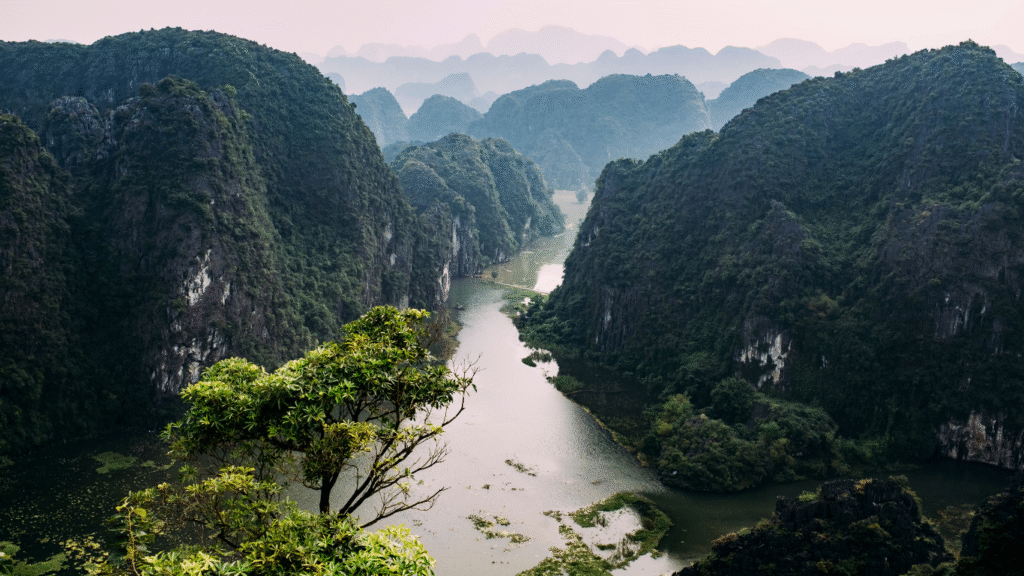Sandhan Valley, tucked in Maharashtra’s Sahyadri mountains, is a dream for adventure lovers. Known as the Valley of Shadows, this 200-foot-deep, 2-kilometer-long canyon offers a thrilling trek filled with rappelling, rock climbing, and camping under the stars. Carved by water over centuries, its narrow gorges and towering rock walls create a dramatic, almost otherworldly vibe. Whether you’re a seasoned trekker or a newbie craving a challenge, Sandhan Valley promises an unforgettable experience. From navigating water pools to stargazing in the quiet wilderness, this trek is about testing your limits and soaking in nature’s raw beauty. In this guide, we’ll walk you through everything you need to know—how to get there, what to expect, and how to stay safe—while keeping it simple and human. Let’s dive into why Sandhan Valley is Maharashtra’s hidden gem and how you can make the most of this epic adventure.
What is Sandhan Valley?
Sandhan Valley is a stunning canyon in the Sahyadri range, near Bhandardara in Maharashtra’s Ahmednagar district. Often called the Valley of Shadows, it’s a 200-foot-deep, 2-kilometer-long gorge shaped by the Pravara River. The valley’s steep rock walls, some narrowing to just 3 feet, block sunlight, creating a shadowy, mystical feel. It’s a hotspot for trekkers, offering a mix of rappelling, wading through water pools, and camping. Surrounded by peaks like Ratangad, Ajoba, and Kalsubai, the highest in Maharashtra, the valley feels wild and untouched. The trek starts at Samrad village and can end there (half descend) or at Dehne village (full descend). It’s not just a walk—it’s an adventure that tests your stamina and spirit while rewarding you with jaw-dropping views.
Why It’s Called the Valley of Shadows
The name “Valley of Shadows” comes from the valley’s narrow gorges, where sunlight barely reaches the ground. The towering rock walls cast long shadows, giving it a dark, eerie charm. This unique feature, combined with the silence of the canyon, makes you feel like you’re in a hidden world. Trekkers love this vibe, especially at dusk when the shadows deepen.
The Geological Wonder of Sandhan Valley
Sandhan Valley is a natural masterpiece, carved by water and wind over thousands of years. The Pravara River eroded the Sahyadri rocks, forming a deep canyon with smooth boulders and steep cliffs. Its 200-foot depth and narrow width make it a rare geological feature in India. The valley’s rugged terrain, dotted with water pools and caves, adds to its wild allure.
Why Trek Sandhan Valley?
Trekking Sandhan Valley is more than just a hike—it’s a full-on adventure that pushes your limits and rewards you with unforgettable moments. Unlike typical treks, it combines rappelling down rock faces, crossing waist-deep water pools, and camping in a remote canyon. The stunning views of Sahyadri peaks like Alang, Madan, and Kulang are a bonus. It’s perfect for thrill-seekers who want to escape city life and dive into nature. The trek’s moderate-to-difficult level suits fit beginners or seasoned trekkers looking for a challenge. Plus, the chance to stargaze in a pollution-free sky or share stories by a bonfire makes it a bonding experience. Sandhan Valley’s raw beauty and unique terrain make it a must-do for anyone craving a mix of adrenaline and peace.
The Thrill of Rappelling and Rock Climbing
Rappelling down 40- to 100-foot rock patches is a highlight of the trek. With professional guides and ropes, you descend steep cliffs, feeling the rush of adrenaline. Rock climbing over boulders and narrow paths adds to the challenge. These activities make Sandhan Valley a favorite for adventure junkies.
Camping Under the Stars
Camping in Sandhan Valley is magical. After a tough day of trekking, you set up tents near a pond or open ground, surrounded by cliffs. The clear night sky, free of city lights, is perfect for stargazing. Bonfires, local food, and ghost stories create a cozy, unforgettable vibe.
How to Reach Sandhan Valley
Getting to Sandhan Valley is straightforward but requires some planning. The trek starts at Samrad village, about 200 kilometers from Mumbai and 230 from Pune. From Mumbai, take a local train to Kasara (3 hours, INR 75) or a bus to Igatpuri. From Kasara or Igatpuri, hire a shared jeep to Samrad (2.5 hours, INR 100-200). Pune travelers can take a bus to Sangamner, then another to Bhandardara, followed by a jeep to Samrad. Driving is an option, but roads get rough after Bhandardara, so a high-clearance vehicle is best. The nearest airport is Mumbai’s Chhatrapati Shivaji International, 99 kilometers from Igatpuri. Trains to Igatpuri also connect from Delhi or Pune. Always check road conditions, especially during rains, and book jeeps in advance for groups.
Best Routes from Mumbai and Pune
From Mumbai, the fastest route is by train to Kasara, then a jeep via Ghatghar to Samrad (180-200 km). From Pune, take a bus to Sangamner, then a jeep via Bhandardara (230 km, 7 hours). Driving from either city takes 4-5 hours to Bhandardara, but the last 30 km to Samrad is bumpy.
Public Transport vs. Private Vehicles
Public transport is cheap and reliable—trains to Kasara or buses to Igatpuri cost under INR 200. Shared jeeps from there to Samrad are budget-friendly. Private vehicles offer flexibility but need careful driving on rough roads post-Bhandardara. For groups, a hired cab from Mumbai or Pune (INR 3000-5000) can be cost-effective.
Best Time to Visit Sandhan Valley
The ideal time to trek Sandhan Valley is November to February, when the weather is cool (15-25°C) and the valley is lush green. Clear skies make for great views and stargazing. May to mid-June is also good for the Fireflies Festival, when the valley glows with tiny lights. Monsoon season (June to September) is dangerous due to flash floods and slippery rocks, so the valley is closed. Summer (March-April) is hot and dry, making the trek tiring, though early mornings can work. Winter offers the best balance of pleasant weather and safe terrain, but nights get chilly, so pack warm clothes. Always check local weather updates before planning, as sudden changes can affect safety.
Winter Trekking Benefits
Winter (November-February) is perfect for Sandhan Valley. Cool temperatures make trekking comfortable, and dry terrain reduces slipping risks. The clear night skies are ideal for camping and stargazing. Water pools are knee-deep, easier to cross than in monsoon. Book guides early, as this is peak season.
Fireflies Festival in May-June
From May to mid-June, Sandhan Valley hosts a natural Fireflies Festival. Thousands of fireflies light up the valley at night, creating a magical scene. The weather is warm but bearable, and the trek is less crowded than winter. It’s a unique experience for nature lovers.
What to Expect on the Sandhan Valley Trek
The Sandhan Valley trek is a 3-5 hour journey covering 8-12 kilometers, depending on whether you do the half or full descend. Starting at Samrad village, you descend into the gorge, crossing knee- to waist-deep water pools and rappelling down rock patches (up to 100 feet). The terrain is rocky, with narrow paths and boulders, so good fitness is key. You’ll need to wade through streams and climb over rocks, guided by professionals for safety. The full descend ends at Dehne village, while the half descend returns to Samrad. Expect stunning views of cliffs, peaks, and ponds, but also challenges like steep descents and cold nights. Carry food, water, and camping gear, as there are no shops en route.
Half Descend vs. Full Descend
The half descend starts and ends at Samrad, taking 3-4 hours with less rappelling. It’s easier for beginners. The full descend goes from Samrad to Dehne, covering 12 kilometers with more rappelling and water crossings. It’s tougher but offers a fuller experience of the valley’s beauty.
Physical Fitness Requirements
Sandhan Valley is moderate-to-difficult, requiring good stamina and leg strength. Steep descents, rock climbing, and wading through water demand fitness. Prepare with cardio, squats, and balance exercises weeks before. First-timers should join guided groups for safety and support.
Safety Tips for Sandhan Valley Trek
Safety is crucial on the Sandhan Valley trek due to its challenging terrain. Always go with a professional guide (INR 600-800) who knows the route and rappelling techniques. Wear sturdy, waterproof trekking shoes to avoid slips. Carry a first-aid kit, flashlight, and enough water (2-3 liters). Avoid trekking in monsoon due to flood risks. Pack light but include warm clothes for cold nights. Stay with your group, as the valley has no mobile signal. Check weather forecasts and inform family of your plans. If crossing water pools, use ropes or local help (INR 20) to stay safe. Don’t litter—keep the valley clean. With preparation and caution, you can enjoy this adventure worry-free.
Essential Gear to Pack
Pack a sleeping bag, mat, tent, and lightweight food (dry snacks, energy bars). Carry a waterproof backpack, headlamp, and extra batteries. Wear quick-dry clothes and bring a jacket for chilly nights. A rope and carabiners are handy for rappelling, but guides usually provide these.
Hiring Local Guides
Local guides from Samrad are a must. They know the valley’s tricky paths and handle rappelling safely. Costing INR 600-800 per person, they also share tips on crossing water pools and camping spots. Book through trekking groups or locals in advance for reliability.
What to Do Beyond Trekking
Sandhan Valley offers more than just trekking. Camping by a pond under a starry sky is a highlight, with bonfires and local Maharashtrian food like bhakri and dal adding warmth. Photography lovers will find endless shots—cliffs, water pools, and sunsets are stunning. Try the Giant Swing (if available) for an extra thrill, swinging 500 feet above the valley. Nearby, visit Ratangad Fort or Kalsubai Peak for more treks, or explore Bhandardara’s waterfalls like Umbrella Falls. Birdwatching at Nandur Madhyameshwar Sanctuary is great for nature fans. After the trek, relax at homestays in Samrad or plush resorts in Bhandardara for a mix of adventure and comfort.
Photography and Stargazing
Sandhan Valley’s dramatic cliffs and narrow gorges are perfect for photos, especially at sunrise or sunset. The clear, pollution-free sky makes stargazing a must—bring a camera with a long exposure for Milky Way shots. Tripods and wide-angle lenses work best.
Nearby Attractions to Explore
Post-trek, visit Ratangad Fort for a moderate hike with epic views. Kalsubai Peak, Maharashtra’s highest, is a tougher climb. Bhandardara’s Umbrella Falls, Wilson Dam, and Arthur Lake are scenic spots. Ratanwadi village offers a charming walk with local culture.
The Future of Sandhan Valley Tourism
Sandhan Valley’s popularity is growing, drawing adventure seekers from across India. While this boosts local economies in Samrad and Dehne, it raises concerns about over-tourism. Littering and untrained trekkers can harm the valley’s fragile ecosystem. Local groups and trekking organizers are pushing for sustainable practices, like waste-free treks and mandatory guides. Maharashtra Tourism promotes the valley as a top adventure spot, but stricter rules may come to protect it. For now, it remains a raw, unspoiled gem, but responsible trekking is key to keeping it that way. By choosing guided tours, respecting nature, and supporting locals, you can help preserve Sandhan Valley for future adventurers.
Sustainable Trekking Practices
To protect Sandhan Valley, carry reusable water bottles and avoid plastic. Pack out all trash and stick to marked paths to avoid damaging flora. Join community-led treks that support locals and follow eco-friendly rules. Small steps keep the valley pristine.
The Role of Local Communities
Samrad and Dehne villagers rely on trekking for income, offering guides, homestays, and food. Supporting them through local bookings boosts their livelihood. They also share knowledge about the valley’s history and ecosystem, enriching your trek experience.



